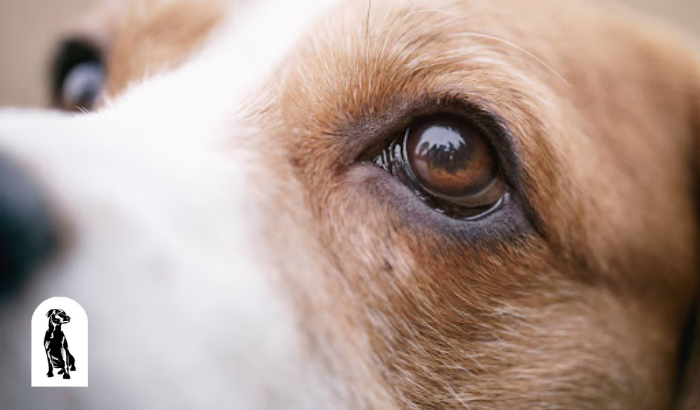
Cataracts in dogs are a common yet serious eye condition characterized by a clouding of the lens, leading to decreased vision and potentially blindness.
Factors like aging, diabetes, injuries, and genetics contribute to the development of cataracts, with certain breeds being more predisposed due to hereditary factors. Recognizing and managing this condition is crucial for maintaining a dog's quality of life.
Lanosterol is emerging as a promising non-surgical treatment that could prevent or even reverse cataracts in dogs by dissolving the protein buildup that clouds the lens. This compound represents a significant advance in veterinary medicine, offering a potential alternative to the costly and risky surgical removal of cataracts.
Surgery, while effective, involves replacing the cloudy lens with an artificial one but comes with potential complications and high costs. For cases where surgery isn't viable, veterinarians might suggest strategies to help dogs better navigate their environment, though these don't treat the underlying cataract.
Early detection and diagnosis are critical. Dog owners might notice symptoms like cloudiness in the eyes, difficulty navigating, or a reluctance to jump or climb, which indicate potential vision issues.
Vets typically diagnose cataracts through detailed eye exams using specialized equipment, occasionally supplemented by imaging tests like ultrasound if the cataracts obscure a clear view of the eye’s interior.
As pet health care evolves, staying informed about treatments like lanosterol is essential. This blog explores lanosterol's potential, backed by research, to change how we prevent and treat cataracts, enhancing the well-being of our canine friends.
What is lanosterol?
Lanosterol is a natural substance that is vital to a dog’s eye health, especially in treating cataracts. It's a type of molecule crucial for making cholesterol, which is important for the health of cell membranes and other key body functions.
Lanosterol also helps keep the eye’s lens clear. It does this by interacting with proteins in the lens, helping to maintain its transparency and preventing the cloudiness typical of cataracts.
The potential of lanosterol to treat cataracts was first recognized in a key study conducted in 2015. Researchers discovered that children who could not produce lanosterol due to a missing enzyme developed cataracts. This led to further studies on animals where applying lanosterol directly to the eye significantly reduced the cloudiness of the lens.
Encouraged by these findings, scientists then conducted human trials with lanosterol eye drops. The results were promising, showing that these drops could stop or even reverse the progression of cataracts by breaking down the protein clumps in the lens.
This breakthrough represents a major step forward in non-surgical treatments for cataracts, providing new hope for effective solutions. Continued research enhances how lanosterol may be used clinically, showing promise for dogs with similar eye conditions. This underlines the growing importance of lanosterol in the future of eye care treatments.

How could lanosterol help prevent cataracts in dogs?
Lanosterol is emerging as a promising candidate for preventing and treating cataracts in dogs, offering a potentially revolutionary approach to canine eye care. Understanding the underlying mechanism of lanosterol’s action and considering its practical application may help pet owners and veterinarians gauge its suitability for individual dogs.
The effectiveness of lanosterol in combating cataracts hinges on its ability to interact with the proteins in the eye’s lens. Cataracts form when these proteins clump together, clouding the lens and impairing vision. Lanosterol helps to maintain the normal structure of these lens proteins, preventing them from aggregating.
Additionally, it may even help dissolve existing protein clusters that contribute to lens cloudiness. This dual action — both preventive and curative — highlights lanosterol's potential as a significant advancement in cataract treatment.
When considering lanosterol for dogs, several practical aspects come into play, notably in terms of administration methods and safety:
Administration methods
Lanosterol is typically administered as eye drops, making it a non-invasive treatment option. This application method is particularly advantageous as it can be done at home, avoiding the need for more stressful and invasive procedures. For effective results, the drops need to be applied consistently, according to a schedule prescribed by a veterinarian.
Ease of use
The ease of administering lanosterol eye drops makes it an attractive option for many dog owners. However, it’s crucial that owners are comfortable with and trained in the proper technique to ensure the medication is delivered effectively to the dog’s eyes.
Safety considerations
Lanosterol has been shown to be safe in initial studies, with minimal to no adverse effects reported. However, as with any new treatment, ongoing research and monitoring are essential to fully understand its long-term safety profile.
It’s important for dog owners to discuss potential risks with their veterinarian and to observe their pets closely for any signs of adverse reactions following administration.
Cost and accessibility
While potentially less expensive than surgery, the cost of regular lanosterol treatment could add up over time. Accessibility is another factor; as lanosterol becomes more widely studied and used, it’s expected to become more readily available to pet owners.
Incorporating lanosterol into a dog’s eye care routine could significantly change how cataracts are managed, shifting some cases from surgical intervention to at-home management. As research progresses, lanosterol may become a staple in preventing and treating early-stage cataracts, helping dogs maintain clear vision without surgery.
What are the pros and cons of using lanosterol?
Understanding this treatment's advantages and limitations helps dog owners make well-informed decisions about their pet's eye health.
Pros of using lanosterol
- Non-surgical treatment: Lanosterol can treat or even prevent cataracts without the need for surgery, reducing risks and recovery concerns.
- Ease of use: Administered as eye drops, lanosterol is simple to apply at home, sparing frequent vet visits and minimizing stress for dogs.
- Vision restoration potential: Early studies show lanosterol might reverse some lens cloudiness associated with cataracts, possibly improving vision and enhancing the dog’s quality of life.
- Safety: Initial studies suggest lanosterol has a favorable safety profile, making it suitable for long-term use, especially in dogs that may not handle surgery well.
Cons of using lanosterol
- Emerging research: Research on lanosterol is still developing. More extensive studies are needed to fully understand its effectiveness and any long-term side effects.
- Variable efficacy: While early results are promising, lanosterol may not work for all cataract types or stages. Its ability to completely clear the lens or prevent cataracts indefinitely is still being evaluated.
- Limited availability: Being a new treatment, lanosterol isn't widely available yet, which may limit access and affect cost, making it impractical for some owners.
- Application consistency: Regular, consistent application of the lanosterol eye drops is essential for effectiveness, which can be challenging if dogs resist treatment or if owners struggle with the application routine.
While lanosterol presents a revolutionary method for managing canine cataracts, weighing these benefits against the drawbacks is essential.
For many, its advantages as a non-surgical alternative might outweigh the cons. Continued research and trials are expected to provide deeper insights into lanosterol's effectiveness, potentially broadening its application as a safe, efficient treatment option for canine eye health.

What should dog owners know?
For dog owners, understanding when to seek veterinary advice and the importance of regular eye exams is essential for managing cataract prevention and treatment effectively. Here are crucial insights and actions to help maintain your dog’s eye health:
When to consult a veterinarian
Consult a vet immediately if you notice changes in your dog’s vision or eye appearance, such as cloudiness, difficulty navigating, or eye redness. Early vet visits are crucial for diagnosing and treating cataracts and ruling out other eye conditions. If considering treatments like lanosterol, a vet can offer tailored advice and monitor treatment effectiveness.
Importance of regular eye exams
Regular eye exams are vital. Veterinarians can spot early signs of cataracts and other eye issues before they worsen. Exams might include tests like slit-lamp examinations or pressure measurements. Puppies, especially those at genetic risk, and older dogs should have frequent checks, as should dogs with diabetes due to their increased risk of cataracts.
Proactive eye care
Between check-ups, monitor your dog’s eyes for signs of problems and keep their environment clean to reduce eye irritants. Consider protective eyewear for your dog during outdoor activities.
Taking proactive steps in eye care, scheduling regular veterinary exams, and consulting with your vet as needed are key to ensuring your dog’s eyes remain healthy, enhancing their quality of life, and maintaining their vision clarity.
Dog eye care and more from Plush Paws

Whether you're already dealing with the challenges of cataracts in your canine friend or looking for preventive measures, understanding the options available will make a significant difference in the way you care for your dog.
At Plush Paws, we are committed to supporting pet owners in providing the best care for their furry family members. Our mission is to ensure that every pet leads a happy, healthy life, and this includes Advanced Lanosterol Solution that will help you keep their eyes healthy and their tails wagging.
For more information on how to maintain your dog’s eye health, visit Plush Paws. We’re here to help you and your pet enjoy a long, joyful, and healthy journey together. Remember, proactive care is the key to managing pet health effectively, and products from Plush Paws are always here to support you every step of the way.
